CiM Tester Feedback
-
Hades has become the “go to” black for many lampworkers.
"Hades is the best black! I love it. It is the only black, that's really black, without the unpleasant side effects such as devitrification or silver shimmer." – Angela Hadorn
“This is the only black I use, it covers ALL the different blacks for me, great for ‘just black’ [i.e. not purple like Effetre etc.], for webbing [i.e. intense black], for great reactions with silver foil, leaf and glasses.” – Elasia
“I do use Hades as I like how it stays black; I mostly use it as stringer. I tend to use Effetre black for basic stuff and Hades when it really matters.” – Julie Fountain
“Hades is my favorite real black.” – Maija-Leena Autio
“Tuxedo is my staple black, because of the price difference from Hades. I love Hades as well, but tend to save it for more special applications.” – Donna Dorman
“I use Hades all the time and think it is the best black on the market.” – Gail Witt
“I prefer Hades to other blacks.” – Jan Whitesel-Keeton
"It is always on the bench when I am working." – Chris Haussler
“I use this black the most out of any of the blacks on the market. It's more affordable, extremely dense, and doesn't bleed out in my murrini, and it's very neutral in tone. I do like that it can give similar effects as the Italian dense black by ‘webbing’, so for me this glass is ideal and has the best of both worlds.” – Renee Wiggins
"Hades does not give you the purple color on white that other blacks have. Hades and silver foil make other silver glasses do amazing things!" – Tina Lamasney
“Hades is my most-often used black, unless I’m using it as filler or someplace not visible, and then I use the less expensive Vetrofond or Effetre Black.” – Kathy Coon
-
What is the difference between Hades & Tuxedo? Hades is our intense black (will maintain its black color even when pulled into stringer) and Tuxedo is our regular black (less dense).
“Hades is definitely more black than Tuxedo. It’s like a ‘premium’ black.” – Laura Sparling
"To me, Hades is a richer, jet black, while Tuxedo looks the same in a solid bead, but when used as decoration like dots or stringer work, it can look a little less saturated black." – Lori Bergmann
"I consider Tuxedo to be a staple and Hades to be a special glass." – Jolene Wolfe
"For me, Hades is a 'true' black and Tuxedo is a very deep grey. Both Tuxedo & Hades will get a bit squirrelly with enough heat." – Chris Haussler
"Hades is denser than Tuxedo. Hades is a nice true black that doesn’t bleed purple." – Teri Yount
"Hades acts more like intense black and it stays black. Tuxedo is black but can go grey on white etc. Hades, when blown or made into a hollow or pulled into a stringer, stays black, not purple." – Elasia
"If you melt Hades into white the resulting line will appear black. If you do the same test with Tuxedo, the line appears more purple. I would definitely describe Hades as a real, true dense black. It is the only black I will use from now on." – Gail Witt
"Hades webs and Tuxedo does equally as much." – Pat O'Brien
-
How does Hades compare to Effetre intense black? Testers reported that they prefer Hades because of its spectacular reactions with silver and its stiffness.
"Hades is easier to control than Effetre intense black, and will reduce in the presence of silver which Effetre intense black will not do." – Carol Oliver
"Hades is stiffer and easier to control when working as a stringer." – Claire Morris
"Both are ‘proper’ black instead of really dark purple or blue or whatever, I chose between the two based on how reactive they are with other colors. Hades does wonderful things with many of the silver or reactive glasses, and has great movement when you want it to spread or web. Hades does everything that Intense Black does, plus it is more color reactive with silver glass, costs less and is much more consistent from batch to batch." – Kathy Coon
"Hades is a more intense black than the Effetre intense black. Hades = Blackgasm. Effetre intense black = dark black. The Effetre will spread and spread whereas the Hades will stay put and behave itself. Hades has a bright glossier shine to it when compared to Effetre, I really like it! The only problem with Hades is that I couldn't see the details as easily as with Effetre. This was due to not getting the dreaded metallic sheen. I did bump my light up a bit and that took care of the problem." – Leslie Anne Bitgood
"Hades and Effetre intense black are about the same. But Hades works great with silver glass and Effetre intense black doesn’t." – Pat O'Brien
"I have only ever used Effetre intense black as fine stringer for lace/web beads – I find that they both behave very similarly for this purpose. Hades tends to be more affordable and also easier to source in the UK." – Jolene Wolfe
"Hades maintains its crispness better than Intense Black. I work Hades very cool when using it as stringer and it keeps its definition that way." – Laura Sparling
"Hades can take more heat before webbing. That might give it an edge in some situations." – Chris Haussler
"Hades is a beautiful reactive black. It is even more dense than Tuxedo but doesn't web like intense black. It can sometimes get a bluish shimmer when used with silver or with silver glass." – Caroline Davis
-
Most testers agreed that Hades is a bit stiffer than the Italian blacks.
"Hades is stiffer, but if it is too hot, it behaves much like intense black." – Angela Hadorn
"I loved the way it webs like intense black does, but the fact that it is stiffer makes all the difference for me. I really like this glass a lot." – Claire Morris
"Hades is more stiff which makes it easier to use for a stringer decoration." – Gail Witt
"If there is a difference, I can’t tell." – Chris Haussler
"Hades was VERY easy to sculpt with; it wasn't as stiff as I thought it was going to be." – Leslie Anne Bitgood
"Hades being stiffer makes it a great color to pull into stringer and to rake with." – Bonnie Polinski
"I find them to be very similar in stiffness." – Jolene Wolfe
"Hades is a stiff glass, it is firmer than Effetre, and takes longer to work, but you get better colors and reactions with it than other glass. I love it reduced especially with other reactive colors on top." – Vonna Maslanka
-
Testers report that Hades does web (but not quite as much as Effetre intense black) and only when super heated. If you are looking for a more crisp effect, then try working in a cooler flame.
"Hades does crawl and I love the effect. It makes great organic beads. The crawling can be controlled by the amount of heating. It will crawl more easily on some colors than others." – Gail Witt
"Hades crawled only when over heated for a long time. I didn't like it, but I could control it by heating it for a less amount of time even when the heat was very hot! In other words it took me a lot of heat for a long time to get it to crawl. If I used a lot of heat for a shorter [reasonable] time it did not crawl." – Leslie Anne Bitgood
"I rely on it for all of the wonderful webby effects that I used to buy Intense Black for." – Kathy Coon
"Hades webs, and the more you heat it the more it will do so." – Laura Sparling
"I found that Hades did seem to crawl more when in the direct heat, and for me this is not a good thing. I like to work close to the flame, so when used to make dots on white, they didn’t stay dots." – Jan Whitesel-Keeton
"Hades webs when heated well. It webs almost as well as intense black, but not quite as dramatically." – Lori Bergmann
"Hades will web, but it doesn't 'spider web' like Effetre intense black does. It is a different effect." – Tim Gottleber
-
Does Hades have any discernible hue? Most testers only saw black, though some reported seeing green, blue, or brown.
"I didn’t notice any base colour – I just saw black, black and more black. Which is nice to see in black glass!" – Claire Morris
"If it is overheated it deepens to a dark brown." – Angela Hadorn
"I know the glass isn’t really black, but I can’t see anything but a dense black, even in stringer." – Gail Witt
"Looks pretty black to me no matter how fine I pull it!" – Laura Sparling
"Hades has subtle brown to grey/green hues but does not show a discernable hue other than black until it is superheated." – Bonnie Polinski
"I saw blue, but only in bright sunlight when pulled into thread stringer." – Leslie Anne Bitgood
"It can have a slight grayish green tint around the edges when melted in as decoration and heated so the edges slightly bleed." – Lori Bergmann
"Hades is a very dense black and I did not notice a purple or green hue to it." – Jan Whitesel-Keeton
-
Some testers reported that Hades will “ghost” or create a thin parallel line next to itself.
"Hades ghost but only when *really* heated." – Claire Morris
"Hades creates a slight halo when overheated- it has a tendency to ghost more on colors where it doesn’t crawl." – Gail Witt
"I noticed ghosting after super-heating the glass." – Vonna Maslanka
"Hades will ghost, but only when boiled." – Leslie Anne Bitgood
"It ghosts with some glasses and not others. Over heating will intensify this effect sometimes. I don't like it when I am trying for crisp lines...it's fun if I am playing organicly. You can control it by encasing it in clear." – Tim Gottleber
-
Special thanks to Genea Crivello-Knable, Gail Witt (x11), Pat O'Brien (x2), Bonnie Polinski, Elasia (x2), & Sue Stewart for providing the photos in this section.
"Moretti black has been out at all distributors so after reading your testimonials I decided to try Hades....and OMG!!!! So excited! I was so shocked that it was just as dark as intense black. Hades just makes my beads POP with color."
– Molly Cooley
|

|
"I've been wanting to have a go at pictorial/painterly beads for a while, and I started with birds of paradise because they have such beautiful plumage . . . . I do like the feathery fuzzing out I got at the side by superheating Hades." Read more at Heather's blog. |
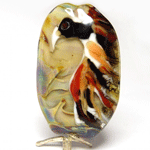
|
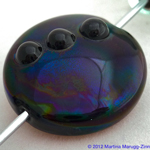
| "This is just Hades over CiM Clear, heavily reduced. Hades can be reduced and it will develop some oil-slick almost shiny surface. The reaction is subtle and only perceivable under pretty good light conditions, i.e. outside. The bead is very shiny and 'mirrory,' but not at all metallic."
–
Martina Marugg
|
"This set of 10 goddess series beads was created on a base of Effetre Emerald transparent with layered dots of Effetre Dark Ivory and mixtures of CiM's Hades and Double Helix rare Psyche Light glasses. Highlights of Double Helix's Aurae, create the bling dots for this set." Read more at Darlene's blog. |
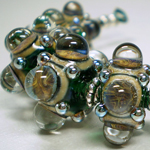
|
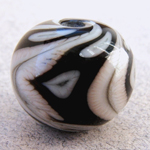
| "I put 4 stripes of Hades on top of ET-204 white, then added 3 dots of the white on each Hades stripe. What I found is really cool! Hades did spider, most noticeably in the direction gravity pulled it as I turned the bead, but also less noticeably in the other direction. The spidering lines, created where the edges blead out over the white, met and collected in the middle of the white areas creating new lines that I had not put there! The spidering lines appear to have a brown hue where gravity pulled the color, and a greenish/black hue where the color spidered up against gravity!"
–
Bonnie Polinski
|
"These pictures are from using Aion frit with Hades and stringerwork of Psyche. The silver glass turned the Hades from black to blue and also gave it a purply blue 'oil on water' metallic sheen. I've tried my best to pick it up with the camera."
– Claire Morris
|

|
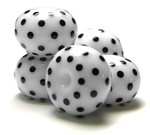
| "These beads are Peace with Hades dots. I've decided that if you work the Hades slowly in a cooler flame it will keep its crispness. If I'd melted these dots in at my normal rate they would have feathered and bled at the edges creating a murky grey-brown halo to the dots. So I went slowly which paid off and the result is crisp jet black on plain white." Read more at Laura's blog. |
“Let's compare Messy Hades and Effetre intense black head to head. Dark Ivory base - with a trail of Turquoise in the center indicated in the image, as it reacted so strongly to the ivory it is hard to spot, and Hades on the left, and Intense Black on the right. Equally cool, but noticeably different. The Hades seems to have spawned more of the fine tendrils, but the Intense Black has pulled up more colour, separating the ivory out into light and dark, and rendering up a nice blue too. I declare them equally awesome.” Read more at DragonJools blog. |
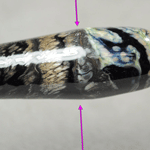
|
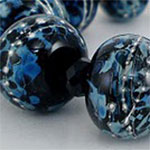
| "On a base of darkest black, CiM Hades, Double Helix's Gaia and Kronos frit was generously sprinkled and reduced to bring out the metallic hues. 99% Fine Silver wire was wrapped and melted in. Effetre glass was then added to magnify the silver glitter captured under it's clear encasement." Read more at Darlene's blog. |
"I used a base of Hades for these beads, it was a fantastic black to work with. It melted extremely smoothly, but was on the stiff side and produced very crisp lentils as a result. The frit is Val Cox’s “Silver Lake” which does this cool thing on black where lots of blue shows up around the edges. A very pretty effect." Read more at Two Glassy Ladies' blog. |
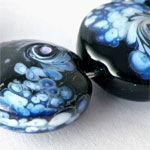
|
"Hades makes Raku pop more than other blacks because it actually stays black instead of getting a sheen of metallic silver on it giving it a more extreme contrast between the deep black to the intense color of Raku."
– Genea Crivello
|
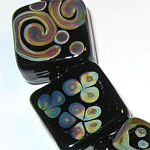
|
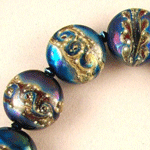
| "Hades, in a reducing flame when exposed to silver, is incredible. I found this out simply by luck one day, and the set of beads that resulted was gorgeous! The bead set is a Hades base with a stringer of Vetro coral wrapped in silver foil, applied, twisted and then the whole bead reduced."
–
Carol Oliver
|
"Midnight Samurai uses a lot of Hades, silver infused for the shards, as thin stringer to create the marbled effect on the silk grey shards and in the twistie/murrini/shardfetti too."
– Jolene Wolfe
|

|